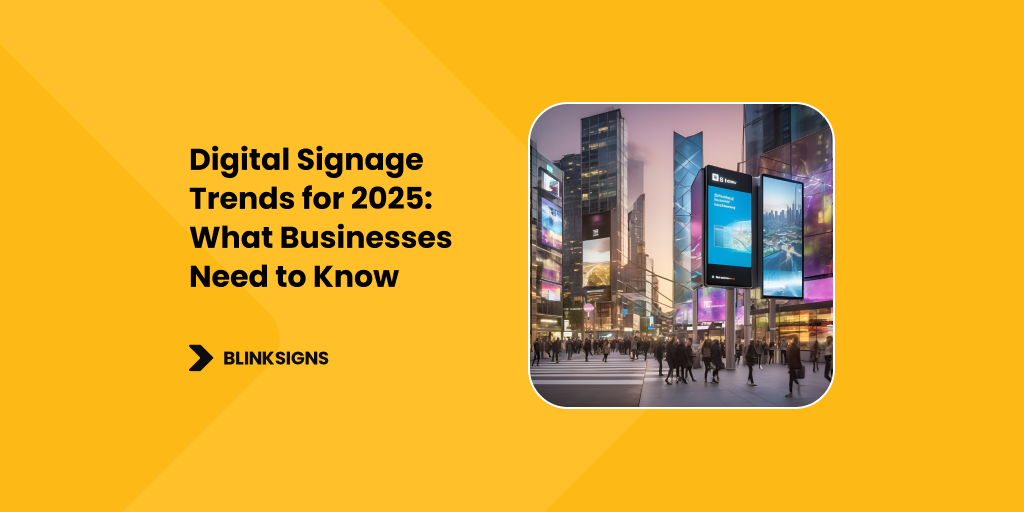
Digital Signage Trends for 2025: What Businesses Need to Know
Digital signage has quickly become a cornerstone of modern marketing strategies, allowing businesses to communicate dynamically and effectively with their customers. As we approach 2025, the technology behind digital signage is advancing rapidly, driven by artificial intelligence (AI), the Internet of Things (IoT), and sustainable practices. These trends are enhancing how businesses use signage and transforming how customers interact with brands.
In this article, we’ll explore the top digital signage trends for 2025 and offer insights on how businesses can leverage these advancements to stay ahead of the competition.
Overview of Digital Signage Evolution
Digital signage has evolved significantly from static displays to dynamic, interactive systems that deliver personalized content to viewers. Originally limited to displaying simple graphics and text, today’s digital signage solutions are far more advanced, incorporating real-time data feeds, customer interaction, and AI-driven content. As we look toward 2025, these technologies are becoming even more sophisticated, offering businesses new ways to capture attention and drive engagement.
The shift from traditional to digital signage has allowed businesses to be more flexible and responsive to customer needs. This flexibility is a key reason digital signage is becoming standard in retail, hospitality, healthcare, and corporate offices.
Key Digital Signage Trends for 2025
The future of digital signage is all about leveraging advanced technologies to deliver more personalized, data-driven content while also offering sustainability and seamless user experiences. Here are the top trends shaping the digital signage landscape in 2025:
- Interactive Signage
- Smart Signage
- AI-Powered Personalization
- Programmatic Digital Signage
- AR and VR Integration
- Sustainability in Digital Signage
- Omnichannel Experiences
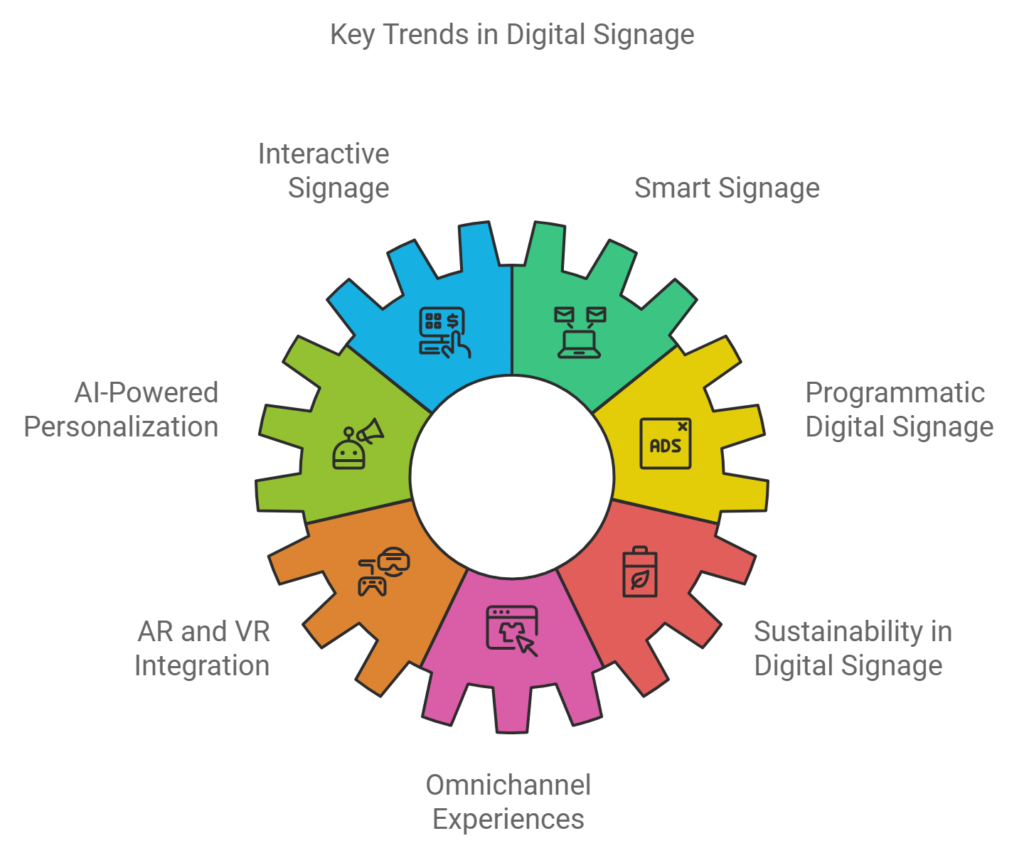
Key trends in digital Signage
| Trend | Description | Business Impact |
| AI-Driven Content Personalization | AI customizes content based on real-time data such as customer behavior and demographics. | Increases engagement and drives personalized customer experiences. |
| Interactive Signage | Digital displays that allow customers to interact via touchscreens, QR codes, or gestures. | Boosts customer interaction and enhances engagement with dynamic content. |
| 3D and Augmented Reality Displays | Immersive experiences created using 3D and AR technologies. | Captures attention in high-traffic areas and provides memorable experiences. |
| Sustainable Signage Solutions | Use of energy-efficient LED displays and eco-friendly materials. | Reduces environmental impact and meets sustainability goals. |
| IoT-Enabled Digital Signage | IoT allows for centralized control and real-time content updates across multiple locations. | Streamlines content management and optimizes signage performance remotely. |
AI-Powered Personalization and Targeting
With the rise of Artificial Intelligence (AI), businesses can now deliver targeted advertising through data-driven signage that adapts in real-time. AI-powered digital signage uses analytics and customer data to display personalized content, tailoring promotions based on demographics, behavior, and preferences. This allows for more effective engagement and increased ROI for marketing efforts.
For example, retail stores can use AI to adjust digital signage content based on foot traffic patterns, showing relevant offers during peak times. This trend will play a crucial role in marketing strategies, helping businesses to target customers more effectively and enhance the overall customer experience.
Immersive Experiences with AR and VR
In 2025, immersive experiences through Augmented Reality (AR) and Virtual Reality (VR) will redefine how customers interact with brands. By integrating interactive kiosks and touchscreen displays with AR/VR technologies, businesses can create engaging experiences that go beyond traditional advertising.
For example, a customer at a retail store can use AR-enabled signage to visualize how a product might look in their home, or a healthcare provider can use VR signage to guide patients through complex treatment plans. This not only enhances engagement but also allows for more interactive and immersive customer journeys.

AR digital signage
The Rise of Programmatic Digital Signage
Programmatic Digital Signage is poised to become a major trend in 2025, especially in Digital Out-of-Home (DooH) advertising. Programmatic signage allows businesses to automate the purchasing and placement of ad space, using data to determine the best time and location for their messages. This trend is revolutionizing the digital signage industry, giving businesses more control over their advertising and enabling real-time adjustments based on performance metrics.
Top digital signage companies are already adopting programmatic solutions, allowing brands to reach their target audience more efficiently and cost-effectively. Whether you’re running a retail campaign or targeting commuters in busy transit hubs, programmatic signage ensures that your message is delivered at the right moment.
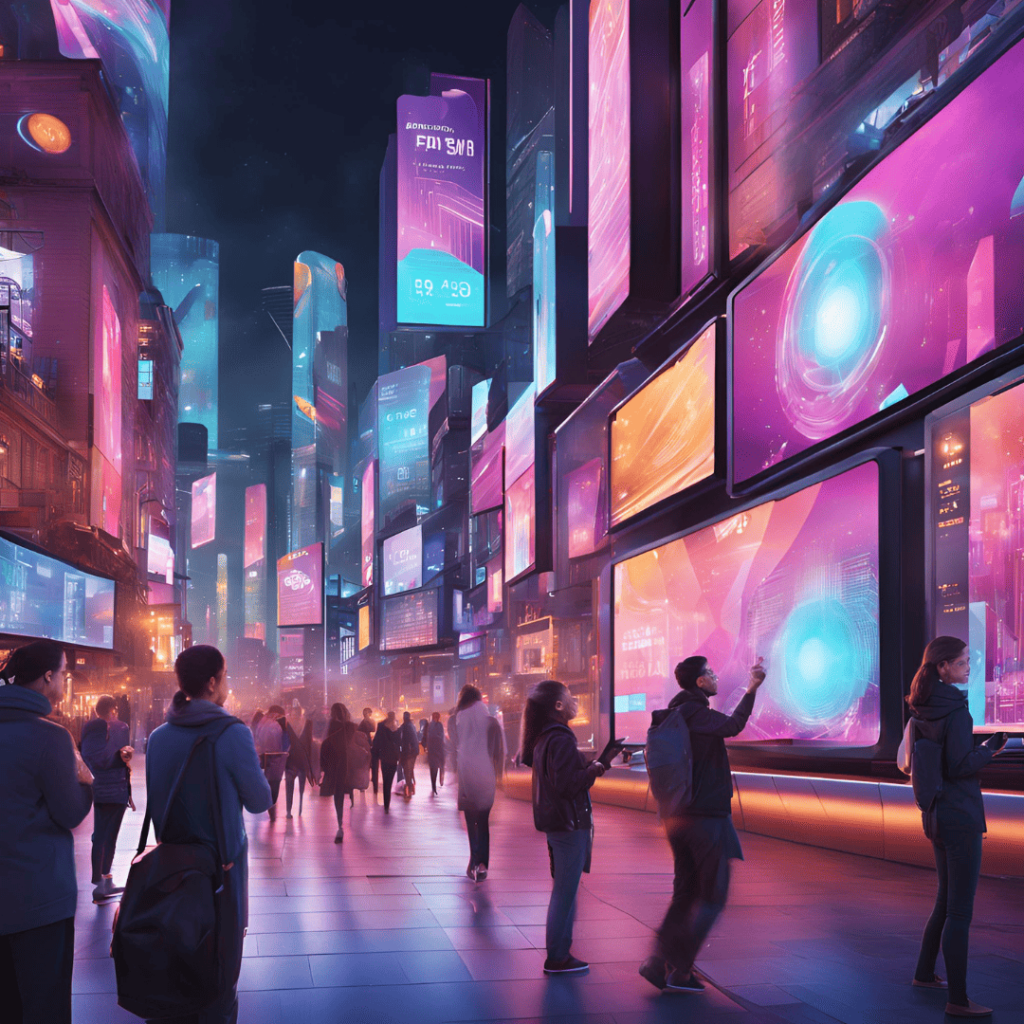
Programmatic Digital Signage
Seamless Omnichannel Experiences
As businesses focus on creating unified customer experiences across multiple touchpoints, seamless omnichannel integration is becoming a must. In 2025, digital signage will be a key player in omnichannel strategies, connecting with other marketing platforms to deliver a consistent and engaging experience. By syncing digital signage with online and mobile channels, businesses can create personalized journeys that guide customers from one platform to the next.
For example, a customer might see an ad on a digital billboard, receive a follow-up offer via email, and then complete the purchase in-store using an interactive digital display. This omnichannel marketing approach increases brand loyalty and ensures that customers receive the right message at the right time, no matter where they interact with the brand.
Sustainability in Digital Signage
With growing concerns about environmental impact, sustainability is becoming a key focus in the digital signage industry. Businesses are increasingly adopting LED displays and cloud-based signage solutions that consume less energy and have a smaller carbon footprint. Additionally, many companies are moving toward eco-friendly materials and recyclable components in their signage solutions, aligning with broader corporate sustainability goals.
In 2025, businesses that embrace green signage solutions will not only reduce their environmental impact but also appeal to eco-conscious consumers. Sustainable signage is a trend that goes beyond technology—it’s about creating a positive brand image and contributing to a more responsible future.
Data-Driven Optimization and Measurement
Data-driven optimization is becoming an essential part of digital signage strategies. In 2025, businesses will leverage real-time data to continuously measure and optimize the performance of their digital signage campaigns. This includes tracking viewer engagement, dwell times, and conversion rates to ensure that signage content is effective and achieving the desired results.
By integrating digital signage with cloud-based content management systems (CMS), businesses can gain valuable insights into customer behavior and make data-driven decisions to improve content performance. This trend allows for constant improvement, ensuring that businesses get the most out of their digital signage investment.
Why Digital Signage is a Game Changer for Businesses
Digital signage isn’t just about technology—it’s about improving customer engagement, boosting brand visibility, and ultimately driving sales. Compared to traditional signage, digital displays can be updated in real-time, making it easier to adapt messaging to current promotions, special events, or even the time of day. This ability to change content on the fly makes digital signage a powerful tool for creating a personalized customer experience.
Additionally, digital signage allows businesses to use engaging media formats such as videos, animations, and interactive touchscreens. This helps brands stand out in crowded environments and provides a more memorable experience for customers. Businesses that adopt digital signage can gain a significant edge over competitors that rely solely on static advertising.
How AI-Powered Analytics Enhance Customer Engagement
AI doesn’t just personalize content—it also provides valuable insights into how customers interact with signage. AI-powered analytics track metrics such as how long people engage with a display, what content resonates the most, and what actions are taken after viewing the sign. This data allows businesses to better understand their audience and refine their strategies to enhance customer engagement.
Moreover, AI can identify patterns in customer behaviour, helping businesses predict future trends. For instance, if AI detects that certain promotions are more popular with younger audiences, companies can adjust their campaigns to target that demographic more effectively.
The Role of Real-Time Data in Dynamic Signage Content
Real-time data plays a crucial role in making digital signage relevant and engaging. By pulling in data from various sources, such as weather conditions, traffic patterns, or sales data, digital signage can display timely and context-aware content. For example, a restaurant could use real-time data to show different menu items based on the time of day or current weather, such as promoting hot soups on a rainy day or cold beverages on a sunny afternoon.
Businesses can also integrate digital signage with their sales systems to display the latest deals and promotions. This ensures that customers always see the most relevant offers, increasing the likelihood of a purchase. The ability to update signage content based on real-time data makes digital signage far more effective than traditional static displays.
Interactive Signage: Engaging Customers in a New Way
Interactive signage is becoming a critical component of customer engagement strategies. By allowing customers to engage directly with digital displays, businesses can create more immersive and memorable experiences. Interactive signage often includes touchscreens, QR code integration, or gesture-based interfaces allowing users to interact without touching the display.
Interactive digital signage encourages customers to spend more time engaging with your brand by browsing product catalogues, exploring new services, or learning more about the company. The more time customers spend interacting with your signage, the more likely they are to take action, such as making a purchase or signing up for a service.
Interactive displays are especially effective in retail settings, where customers can use them to look up product information, check inventory, or customize orders. In healthcare settings, interactive signage can provide patients with detailed information about services or direct them to the right department.
QR Code Integration: Bridging Physical and Digital Engagement
QR codes have become popular for connecting physical signage with digital content. By scanning a QR code on a digital sign, customers can be directed to a website, app, or online promotion. This seamless integration allows businesses to extend the interaction beyond the physical display, offering customers additional information or the opportunity to purchase directly from their mobile devices.
QR codes are also highly versatile. Retailers can use them to offer exclusive discounts, restaurants can display menus, and service-based businesses can schedule appointments. Their ease of use and widespread adoption make them an effective tool for enhancing customer engagement.
How Gesture-Based Interactions are Changing Digital Displays
Gesture-based interactions take digital signage to the next level by allowing customers to interact with displays without touching them. Using motion sensors, customers can wave or point to control the content on the screen. This technology is particularly useful in high-traffic areas where customers may want to avoid touching a screen physically or in healthcare settings where hygiene is a concern.
Gesture-based signage offers an engaging, futuristic experience that captures attention and encourages interaction. Businesses that adopt this technology can differentiate themselves by providing a novel and exciting way for customers to engage with their brand.
The Rise of 3D and Augmented Reality Displays
As businesses look for new ways to stand out, 3D and augmented reality (AR) displays are emerging as key trends for 2025. These technologies allow enterprises to create immersive and visually striking experiences that captivate audiences.
3D digital signage goes beyond the flat, two-dimensional displays we’re used to seeing. These displays create the illusion of depth, making the content appear as though it’s coming from the screen. This can be incredibly effective in high-traffic locations like malls, airports, or busy city streets, where businesses must quickly capture attention.
Augmented reality (AR) signage takes interactivity to the next level by overlaying digital content in the real world. For example, a clothing store might use AR to allow customers to “try on” outfits virtually by looking into an AR mirror. Restaurants can use AR menus to provide detailed dish information, including preparation videos or nutritional content.
Benefits of 3D Signage for High-Traffic Locations
3D signage is particularly effective in environments with heavy foot traffic, where businesses must capture attention quickly. The illusion of depth created by 3D displays makes the content stand out, drawing the eye and encouraging interaction. Whether used for promotional displays or brand messaging, 3D signage offers an impactful way to differentiate your business in crowded spaces.
3D signage can be the key to cutting through the noise and attracting more customers for businesses operating in places like shopping malls, airports, or busy streets.
Augmented Reality: Enhancing Customer Experiences with AR Signage
Augmented reality (AR) can transform customer interactions by blending the digital and physical worlds. AR signage enables customers to interact with products or services in ways that were previously unimaginable. For example, customers can use AR signage to see what furniture might look like in their homes or to explore virtual 3D models of products in-store.
The immersive nature of AR helps businesses create memorable customer experiences, fostering a deeper connection between the brand and its audience.
Sustainable Digital Signage Solutions: A Greener Approach
Sustainability is becoming a critical factor for businesses across all industries, and digital signage is no exception. As customers become more environmentally conscious, businesses seek ways to reduce their carbon footprint. Sustainable digital signage solutions are now emerging as a key trend for 2025.
Businesses are finding ways to make their digital signage solutions more eco-friendly, from using energy-efficient displays to incorporating recycled materials. LED technology and solar-powered digital signage are two of the most popular solutions for reducing energy consumption and environmental impact.
Energy-Efficient LED Displays: Reducing Power Consumption
LED displays are known for their bright, high-quality visuals, but they also have the added benefit of being energy-efficient. Compared to traditional displays, LED signs consume far less power, making them an environmentally friendly option for businesses. In addition to their energy savings, LED displays offer exceptional longevity, reducing the need for frequent replacements and further minimizing waste.
Businesses that use LED digital signage can expect significant savings on their energy bills while contributing to a greener planet.
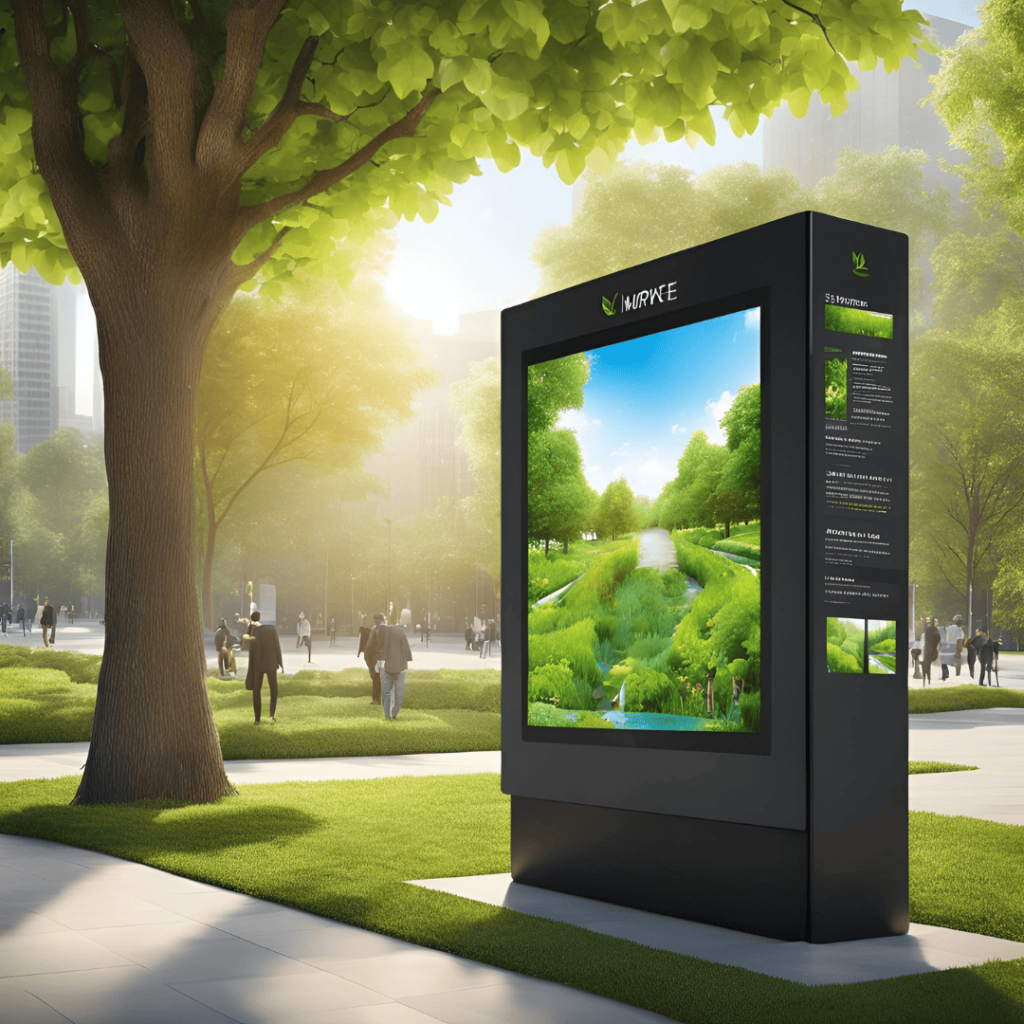
Energy-Efficient LED Displays
Solar-Powered Digital Signage: Harnessing Renewable Energy
Solar-powered digital signage is becoming increasingly popular as businesses seek ways to reduce their reliance on non-renewable energy sources. Solar panels can be integrated into digital signage systems, allowing businesses to run their displays entirely on solar energy. This reduces operating costs and helps companies to meet their sustainability goals.
Solar-powered signage is particularly useful for outdoor environments with limited access to traditional power sources. Businesses can set up digital displays in remote areas or along highways, providing impactful messaging without the environmental costs.
How IoT is Revolutionizing Digital Signage Management
The Internet of Things (IoT) is a game-changer for digital signage management. By connecting signage systems to a network of devices, businesses can remotely monitor and update their displays in real time. This centralized control reduces the need for manual updates and ensures consistent content across multiple locations.
IoT also allows businesses to gather data from their digital signage, providing insights into how customers interact with displays and what content is most effective. This data-driven approach helps companies to make informed decisions and optimize their signage strategies for better results.
Centralized Control of Digital Signage via IoT
Centralized control through IoT means businesses can manage all of their digital signage from one platform, regardless of how many locations they operate in. This is especially useful for franchises or multi-location businesses, where maintaining consistency across sites can be challenging. From updating promotions to monitoring system performance, companies can ensure that their digital signage runs smoothly and delivers the right message at the right time.
Smart Data Integration for Personalized Content Delivery
One of the most powerful features of IoT-enabled signage is its ability to pull data from other systems and integrate it into the content displayed. For instance, retailers can sync their point-of-sale system with digital signage to display real-time inventory updates or promotions on high-margin items. This smart data integration makes digital signage more relevant and personalized, ensuring that customers always see meaningful content.
How Retailers Use AI-Driven Digital Signage to Boost Sales
Retailers are at the forefront of using AI-driven digital signage to personalize customer experiences. By analyzing shopper data, AI systems can display tailored promotions, suggest products, and even change messaging based on foot traffic patterns.
For example, a food chain might use digital signage to showcase different food items depending on the demographics of the customers in-store at any given time. This personalized approach has increased customer engagement and driven higher sales.
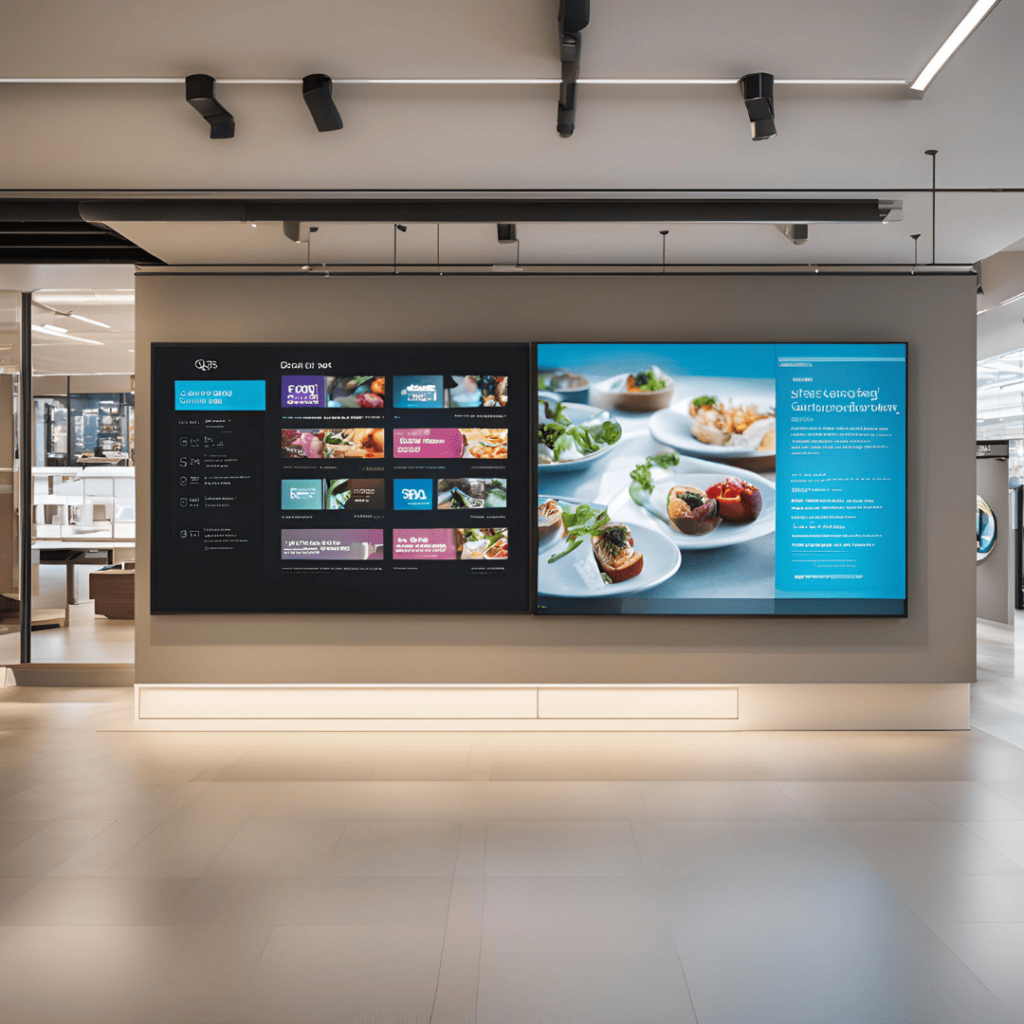
Indoor signage
Conclusion
Digital signage trends for 2025 present exciting opportunities for businesses looking to elevate their customer engagement and brand visibility. From AI-driven content personalization to sustainable signage solutions, the future of digital signage is dynamic and full of possibilities. By embracing these trends, businesses can stay ahead of the curve and create more impactful, memorable customer experiences.
At BlinkSigns, we’re at the forefront of these trends, offering innovative digital signage solutions that help businesses succeed in a rapidly changing landscape. Contact us today to explore how we can future-proof your digital signage strategy.